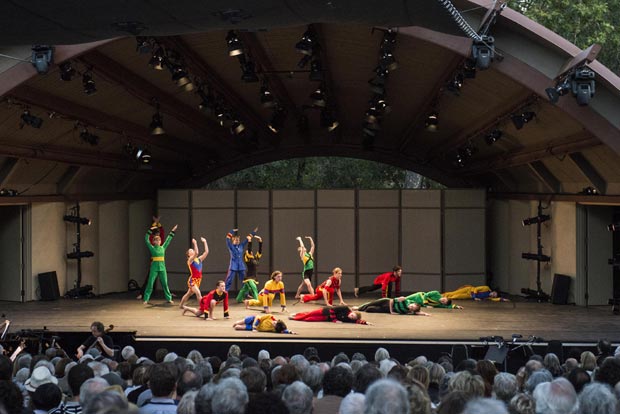
© Timothy Norris. (Click image for larger version)
Mark Morris Dance Group
Ojai Music Festival
Program One: Mosaic and United, Empire Garden
Program Two: Excursions, Jenn and Spencer, Grand Duo
Libbey Bowl
7 June 2013
markmorrisdancegroup.org
www.ojaifestival.org
Dancing to American Music in Ojai
Mark Morris is halfway through his tenure as Music Director of the Ojai Music Festival (June 6-9). The festival elects a guest director each year; Morris is the first choreographer to get the job. The seemingly ubiquitous Morris has now taken to calling the current season “my festival”; he’s only half kidding. The centerpiece of the second evening (June 7) was a performance by the Mark Morris Dance Group – the only dance performance – at the outdoor Libbey Bowl, a fantastically pleasant amphitheatre set within a park in the center of bucolic Ojai. Pleasant, but not ideal for dance: the stage is trapezoidal, has no wings, and doesn’t provide ideal sight lines. But that’s what summer festivals are all about. It’s cool, the night air smells of flowers and the encroaching dusk bathes the proceedings in a lavender glow.
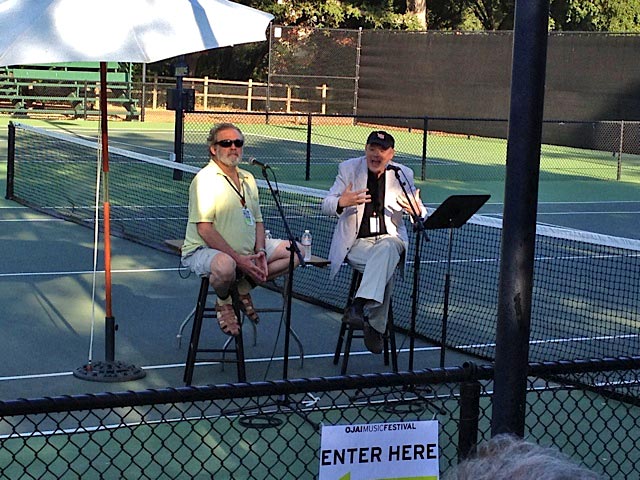
© Marina Harss. (Click image for larger version)
The focus this year is on American music, mostly by composers from the West Coast, and more specifically by composers connected to the Seattle-born Lou Harrison (1917-2003), an old friend of Morris’s whose music he has turned to again and again. Other recurring names are Henry Cowell and Charles Ives, with side excursions into the work of John Luther Adams, John Cage and Samuel Barber. Most of these composers are mainstays of the Mark Morris troupe. The evening was split into two halves, separated by a magical sunset performance of works for toy piano by Satie and John Cage (played by Yegor Shevtsov, a lanky dreamer).

© Timothy Norris. (Click image for larger version)
In the first half, the company performed Mosaic and United, two inter-related pieces from 1993 set to Cowell string quartets (the third and the fourth). These were followed by Empire Garden, an enigmatic and rather haunting work from 2009, set to Charles Ives’s Trio for Violin, Violoncello and Piano. After the toy piano concert, the second dance instalment began with Excursions (2008), a bit of abstract Americana with strong echoes of Agnes de Milles’s Rodeo and music by Samuel Barber. This was followed by the recent Jenn and Spencer, a highly-charged pas de deux with music by Cowell (Suite for Violin and Piano). And, as a finale, one of Morris’s most striking works, Grand Duo from 1993 (to Harrison). A very full evening without a single weak link from beginning to end. And one that proves Morris’s range, even when limiting himself to this small family of composers. Where Jenn and Spencer is emphatic and dramatic, almost violent – it ends with a harrowing slap – Empire Garden is mysterious and laced with hidden messages. Grand Duo, too, explores violence, but this time on a tribal, almost animal level. It includes a battle scene right out of Lord of the Flies, underscored by jabbing descending chords of uncertain tonality. Excursions is nostalgic, expansive and filled with stylized imagery of the west: gallops and square dances, cowboy walks and taps on the ass, kids ducking under imaginary fences and arms whirling invisible lassoes. And beyond that an overriding feeling of space: wide vistas, eyes gazing at the horizon like the characters in Martha Graham’s Appalachian Springs.

© Timothy Norris. (Click image for larger version)
Mosaic and United are really a single piece in two parts, united in part by images of solitude and dejection, isolated figures who stand apart with downcast eyes, hands held to their necks as if seen in mid-reflection. The two works share a variety of motifs – a swivel in attitude to the side, a spiraling arm that seems to sculpt the air as the dancer’s body spirals, followed by a pendulum swing of the other arm. In one section a rhythmic swatting marks the two-and-the-three, and then the five, of a five-beat measure. As the musical context – the tempo, the accents, the mood – shifts, so does the way we perceive each of these motifs and the feelings they evoke. Morris is a master of the repurposed gesture. The first piece is more pensive, more sculptural, the second more tender and playful. At one point in United, two men walk hand in hand, inseparable friends tracing quiet trajectories across the stage, narrowly missing other diagonals of dancers or pausing to lift a dancer in their path. Both the Cowell and Grand Duo are enlivened by raucous folk-dance passages, with rollicking, syncopated rhythms for the feet, bodies swaying in response to big, traveling steps. The closing polka in Grand Duo is as unhinged as The Rite of Spring is supposed to be: arms jabbing, hair flying, bare feet slapping against muscular thighs to mark heavily accented, syncopated rhythms. It’s as thrilling in its way as the profusion of arms and legs in the finale of Balanchine’s Symphony in C.

© Timothy Norris. (Click image for larger version)
It’s good to see Empire Garden again. Like Grand Duo, it features a large cast (fifteen dancers), in this case clad in brightly-colored, cartoonish army (or bell-hop) uniforms by Elizabeth Kurtzman. The movement, too, has a military, puppet-like air. Dancers hold their hands to their hearts or are lifted up by their brethren, gesticulating wildly as if preaching to a band of religious fanatics. The “followers” respond with herky-jerky movements and marches, or hold their fists to their palms. Ives’s music is spiked with college songs and religious hymns, layered on top of one another in a kind of pseudo-Romantic mess. At one point the dancers roll across the floor with their mouths and eyes wide open. Something sinister is certainly afoot. When the dancers pair up and attempt to engage in social dancing – in rigorously gender-neutral couples – they can’t quite connect: their stiff arms jab the air instead of curving in an embrace. A few of the dancers lower themselves to the ground to be led by the neck, like pets on an evening walk. The notion of domination is heavily implied.

© Timothy Norris. (Click image for larger version)
As always, Morris’s ability to shape the sounds coming from the pit through a combined language of gesture and seemingly simple movement is a constant source of surprise and almost primal satisfaction. Why does the swishing of a hand set to a two-note figure in the strings or a carving of the air to a line of melody feel so right? Who knows. But Morris seems able to somehow “capture” the outline of a sound or structural element and illustrate it, as if the shape had been there all the while, just waiting to be revealed. (He’s maniacally exacting about each effect. When, during the first program, a faulty communication between stage and pit caused a missed cue, Morris got up and walked to the stage and told the dancers and musicians to begin again. Excessive? Perhaps.

© Timothy Norris. (Click image for larger version)
And then there are Morris’s dancers: plainspoken and direct, always engaged with each other and the orchestra. They tell it like it is, with no bull, no adornment or prettification. They don’t oversell their wares, and this makes them all the more touching. With their help, Morris has practically guaranteed the success of “his” festival.









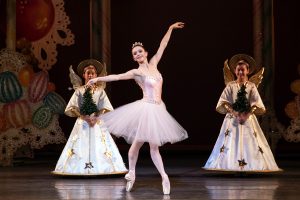


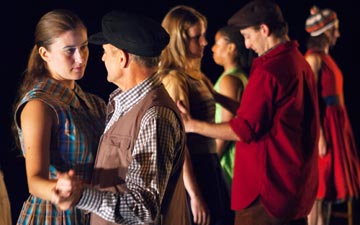


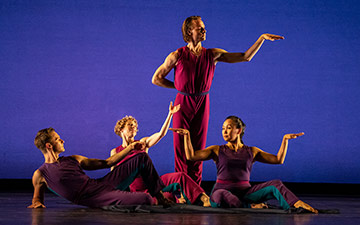

You must be logged in to post a comment.